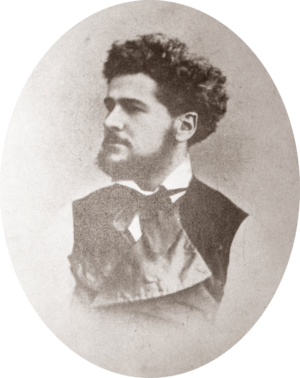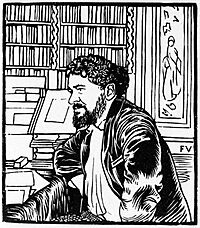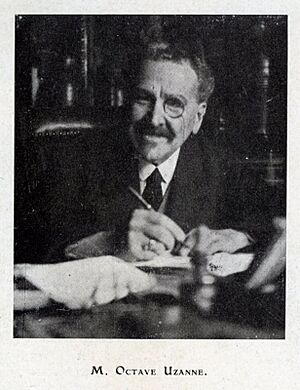Octave Uzanne facts for kids
Quick facts for kids
Octave Uzanne
|
|
|---|---|

Photography by Nadar (c. 1890)
|
|
| Born | Louis Octave Uzanne 14 September 1851 Auxerre, France |
| Died | 31 October 1931 (aged 80) Saint-Cloud, France |
| Occupation | Writer, journalist, publisher |
| Nationality | French |
| Period | 19th century |
| Signature | |
Octave Uzanne (French pronunciation: [ɔktav yzan]; 14 September 1851 – 31 October 1931) was a 19th-century French bibliophile, writer, publisher, and journalist.
He is noted for his literary research on the authors of the 18th century. He published many previously unpublished works by authors including Paradis Moncrif, Benserade, Caylus, Besenval and Baudelaire. He founded the Société des Bibliophiles Contemporains, of which he was president. His research produced a considerable literary output and frequent publications in newspapers such as L'Echo, Le Plume, Dépêche de Toulouse, Le Mercure de France, Le Gaulois and Le Figaro of Paris.
One of the topics his research focused on was the discussion of fashion and femininity in the French fin-de-siècle. This took the form of monographs and works including Son Altesse la femme (French for Her Highness Woman), Féminies and La Française du siècle (The Frenchwoman of the Century). His own works include novels and fantasy books, such as Surprises du Coeur and Contes pour les bibliophiles (Tales for bibliophiles).
Contents
Biography
Early life
Louis Octave Uzanne was born on 14 September 1851 in Auxerre, to a bourgeois family originating from Savoy. His parents were Charles-Auguste Omer Uzanne, a merchant, and Elisabeth Laurence Octavie; his elder brother Joseph, had been born the previous year. His classical studies began in his home town; he moved to Paris after his father's death to study at the Collège Rollin in Paris—a residential school for the children of the French upper-class. In Paris he became interested in the evolution and history of manuscripts and books. During the Franco-Prussian War of 1870–1871 he was attached to a school at Richmond in England. Continuing with law studies, he abandoned this line of work when he came into an inheritance in 1872, allowing him to pursue his literary interests.
He became a regular visitor of the Library of the Arsenal, where he joined a group of followers of the former librarian, Charles Nodier, along with the journalist Charles Monselet, writer Loredan Larchey, and author and bibliophile Paul Lacroix. He also joined the Société des Amis des Livres (founded in 1874), the first French bibliophilic association since the Société des Bibliophiles François (founded in 1820).
At the start of his career, Uzanne focused on the lesser-known writers of the 18th century, creating four volumes of work published by Jouast, and an additional 20+ volumes published by Albert Quantin. He was an admirer of the Goncourt brothers, who were also writers on the subject of 18th-century France. Uzanne looked for mentors who were bibliophiles like him, rather than literary scholars (érudits) like his companions at the Arsenal. While focusing on past subjects, he was very up-to-date on the technical aspects of printing and publishing. His 1879 work Le bric-à-brac de l'amour (literally, A bric-a-brac of love) was one of the first to employ the gillotage, a zincography technique, and photo-mechanical reproduction. Jackson points out that Uzanne, in Les Zigzags d'un curieux (literally, Zigzags of a Curious Man), divided the book collectors in two groups: those who are interested in the book as if it were a kind of stock market share (valeur de Bourse), a market quotation whose fluctuations "they follow with a gamester's interest", and those—whom he considers "pures"—attracted to the book itself, its contents, rarity or beauty.
Bibliophile and journalist
After leaving the Société des Amis des Livres, which he found too conservative and too concerned with the reissue of old works, he started two new bibliographic societies, the Société des Bibliophiles Contemporaines (1889–1894) and the Societé des Bibliophiles Indépendants (1896–1901). The first consisted of 160 people, including the writers Jules Claretie and Jean Richepin, the artists Albert Robida and Paul Avril, and the journalist and critic Francisque Sarcey. Uzanne also edited two magazines, Conseiller du bibliophile (literally, Adviser of bibliophile, 1876–1877) and Les miscellanées bibliographiques (The Bibliographical Miscellany, 1878–1880), and then ran three consecutive bibliophilic magazines: Le livre : bibliographie moderne (literally, The Book: Modern Bibliography, 1880–1889), Le livre moderne : revue du monde littéraire et des bibliophiles contemporaines (literally, The Modern Book: Journal of the Literary World and Contemporary Bibliophiles, 1890–1891), and L'Art et l'Idée : revue contemporaine du dilettantisme l'littéraire et de la curiosité (Art and Ideas: Contemporary Journal of the Literary Dilettantism and Curiosity, 1892–1893). In the early 1890s, he was considered to be "... the best authority that book lovers know on subjects specially interesting to book lovers". Nevertheless, such books as Le Miroir du Monde (The Mirror of the World) or L'ombrelle – le gant – le manchon (The Sunshade, Muff, and Glove) received negative reviews from some newspapers for Avril's illustrations.
In contrast to most bibliophiles of his time, Uzanne was chiefly interested in the creation of new, luxurious bibliophile works, collaborating closely with printers, binders, typographers and artists (especially the Symbolists and early Art Nouveau artists). Among them were such painters as James McNeill Whistler, Adolphe Lalauze and Jules Barbey d'Aurevilly—who wrote the preface of Le bric-à-brac de l'amour (1879)—, the writer Jean Lorrain, and jewellery artists and exponents of Japonisme such as Henri Vever. One of the main artists collaborating with Uzanne was the Belgian Félicien Rops, who illustrated some of his books and created the cover illustration for Le Livre Moderne, and who called Uzanne "the Bibliophile's dream". The overall quality of Uzanne's books was remarked upon by The New York Times when reviewing his 1894 work La Femme à Paris: "The book is a highly-artistic achievement in a typographical sense ... This artistic element and the style of the author ... elevate the work from its sphere of usefulness into the sphere of pure literature. It will be serviceable a century from now to students of our civilization." Other symbolic works of art were Féminies (1896), in which Rops illustrated many scenes of worldly life, or Son Altesse la femme (Her Highness Woman, 1885). In the work he explored the lives of women at all levels of French society of his time. But also, according to Silverman, Uzanne intented to prove the inability of women to merge into public life and the labour market, because of their temperament. Uzanne further indicated that the female figure and ornaments were essential in the French decorative arts, something that was missing in the early 20th century.
Uzanne's bibliophile activity in the early 1880s coincided with the gradual abandonment of manual methods of printing illustrations kin favour of photomechanized methods. His collection of contemporary bibliophilic books was sold in 1894 by Hôtel Drouot. It contained some of the finest examples of late 19th-century French bookbinding, by binders like Charles Meunier, Lucien Magnin, Pétrus Ruban, Camille Martin, René Wiener and Victor Prouvé.
Uzanne was also well known in the literary circles of his day, as attested by this poem of Stéphane Mallarmé in Vers de circonstance (1920):
Non comme pour étinceler
Aux immortels dos de basane
Tard avec mon laisser-aller
je vous salue, Octave Uzanne(Not as if to sparkle with mirth
I greet you, Octave Uzanne)
at the immortal sheepskin spines
late with my usual sloppiness—Stéphane Mallarmé (Zwerling Sugano 1992, p. 246)

As a journalist, sometimes employing the pseudonym "la Cagoule", Uzanne wrote for L'Écho de Paris, Le Gaulois and other newspapers. In addition, for other French and foreign magazines like The Studio, Magazine of Art, and Scribner's Magazine, for which he wrote in 1894 an article, "The End of Books", which he thought would come because of the rise of phonography, where he predicted the rise of radio and television. Uzanne was fascinated by modern technology and the possibilities it offered for the reproduction and dissemination of words, sounds, and images, which was evidenced not only in that article or in his groundbreaking work in book publishing, but also in an article he wrote in 1893 for the French newspaper Le Figaro, about a visit he made to US President Grover Cleveland and the inventor Thomas Edison during the EXPO Chicago 1893, where he witnessed the Kinetograph shortly before it went public.
Books and women, these were the first of Uzanne's loves, and I do not think he has disowned them, because the library is always full of invaluable and rare books, and the first book that he wanted to retouch and republish for the general public, is precisely a monograph of the Parisienne. ... One thinks Sébastien Mercier and Restif de la Bretonne, and no wrong. It is between these two great observers of French mores and the human heart has its place naturally Octave Uzanne.
In general, Silverman assigned to him "anti-Semitic tendencies" and the Bibliothèque nationale de France is credited with the authorship of the anti-Semitic pamphlet Israël chez John Bull : l'Angleterre juive (1913), under the pseudonym "Théo-Doedalus". The journalist Gustave Geffroy, in the prologue of Pietro Longhi (1924) by Uzanne, also listed this work among other works of Uzanne. On this pamphlet, he criticized the British government, including figures as Benjamin Disraeli and Nathan Mayer Rothschild. Uzanne collaborated with Edouard Drumont on his antisemitic newspaper La Libre Parole. Drumont and Uzanne held a cordial friendship through mail, and Uzanne helped him in the publication of the essay La France juive (Jewish France, 1886).
As an art critic, Uzanne wrote several reviews of etchings, as in a critique of French painter and illustrator Félix Buhot: "Buhot is a visionary, one obsessed by the picturesqueness of modern life; nervous to excess, tortured by a crowd of fleeting impressions and queer ideas, he suffered from a cruel inability to reproduce them as he wished." Uzanne's written style was characterized by the use of Anglicisms and eccentric neologisms.
Fashion writer
Another of Uzanne's interests was female fashion, about which he wrote a number of books and articles that were later translated into English. Specifically, he was focused on the image of the Parisienne, the women of Paris. Uzanne is perceived by some to have had a desire to revive French national pride; he shared the nationalistic feelings of other members of the generation who had experienced the defeat by Prussia in 1870. This was reflected in their efforts to promote a renewal of the decorative arts. His first and perhaps most famous book on fashion was L'Éventail (1882, translated as The Fan in 1884), a "delightful" illustrated story about the hand fans. He admitted that his book "in no way a work of powerful wisdom and erudition", but simply the first in a projected series of "little books for the boudoir".
"Among the jewels of female ornamentation, the fan is the priority because, in the land of grace and spirit, still shines in the front row."
— (cf. Octave Uzanne, L'Éventail, 1882, p. 6)
His second book about fashion, L'ombrelle – le gant – le manchon (1883, translated in the same year as The Sunshade, Muff, and Glove), was also illustrated in rococo style by Paul Avril; in one of its lines Uzanne emphasized a female clothing accessory: "The muff!", he said, "Its name alone has something adorable, downy, and voluptuous about it." Later he published Les ornements de la femme (1892), that reproduced in one volume the combined texts of L'Éventail and L'ombrelle – le gant – le manchon. His 1898 work Monument esthématique du XIXe siècle : Les Modes de Paris, translated as Fashions in Paris, was according to the review in The New York Times "... the most complete and exhaustive work on the subject of French fashions that has yet appeared". However, in this book he wanted to re-establish the intimate and feminine culture of the rococo—but during his life he became influenced by modernism— and also he criticized the "sartorial severity" of the femme nouvelle.
An example of the historical novel is La Française du siècle (1886, published in English as The Frenchwoman of the Century in 1887), where Uzanne suggests that the effect of the Revolution on the woman of the period was "lamentable and disastrous": "All French spirit, grace, and finesse seemed to have been submerged in the bloody deliriums of the crowd." Although he focuses on the French Revolution, the story ends in the 1880s, shortly after the Second French Empire, closely following the evolution of society and women (see also Historiography of the French Revolution). Later, he republished what was essentially is the same book but with a different title, in both French and English: La Femme et la mode. Métamorphoses de la parisienne de 1792 à 1892 or Woman and Fashion: Metamorphoses of the Parisienne 1792–1892 in the English version (1892), and Les Modes de Paris. Variations du goût et de l'esthétique de la femme, 1797–1897 (1897). According to the Westminster Review, the English edition was practically a facsimile of the French, and the translator literally wrote the sentences to the point of unintelligibility.
Later life and death
Uzanne never married. Uzanne's feelings toward women, as well as those of Jules Barbey d'Aurevilly, were ambivalent in nature, a mixture of attraction and indifference. He also explored the concept of woman artists, subscribing to the view that women lack creative ability, a quality he associated solely with men.
Silverman mentions that he became in an "archetypal figure of the Belle Époque", a "handsome monsieur with a beard" (joli monsieur avec une barbe) admired by Félicien Rops, and an "elegant storyteller" (l'élégant conteur) according to Anatole France. Silverman notes a contrast between the snobbish, dandy and reactionary side of Uzanne with a penchant for forgotten authors of the 17th and 18th centuries, and he, in turn, was an innovative artist and bibliophile, the antithesis of the antique collectors of the "old guard", formed by bibliophiles—mostly aristocrats—who organised the Société des Bibliophiles François. Uzanne spent his last years in his apartment in Saint-Cloud, where he died on 21 October 1931. His remains were cremated at the crematorium and cemetery Père Lachaise.
Monsieur, you have the feeling of women [le sentiment de la femme]. You have what no one else has in our cold era: a loving imagination.
—Preface of Barbey d'Aurevilly in Le bric-à-brac de l'amour by Uzanne, 1879, p. X
See also
 In Spanish: Octave Uzanne para niños
In Spanish: Octave Uzanne para niños





